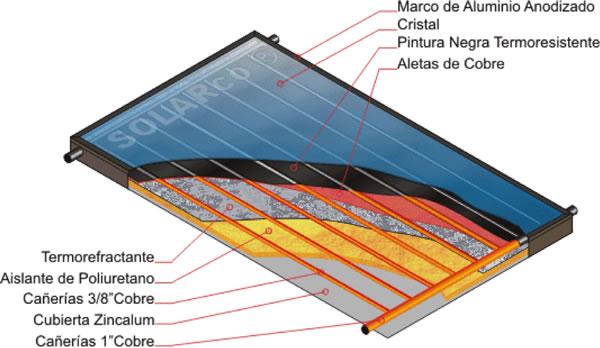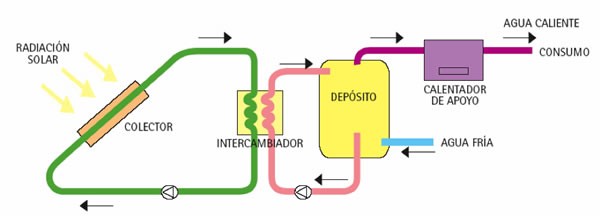Thermal Solar - Water Heating - TS
¿ But how does a solar water heater work?
A solar heater has a normally metallic flat surface, called a collector in charge of collecting the incident radiation from the sun to later transfer it to the water as heat. The colector is a usually dark and matt element to capture as much radiation as possible, avoiding the reflection of sunlight. That is why some of the collectors / collectors are superficially treated with anti-reflective coatings or varnishes.

Once the collector is able to concentrate a certain amount of heat, it must be transmitted to the liquid that we want to heat (normally domestic sanitary water) through a coil installed just below the collector. In this way, a heat exchange is carried out between both parts, producing a heating of the fluid circulating through the coil.
This heat exchange can be done in two ways resulting in two types of heaters:
Natural circulation solar water heater or thermosiphon: The fluid circulating through the coil just below the collector moves due to heating. This type is widely used for its constructive simplicity, low maintenance cost and final cost of the solar heater.
Forced circulation solar water heater : The fluid that circulates through the coil below the collector moves thanks to the intervention of a pump that recirculates it. This type of heater achieves more thermal efficiency than the previous ones but requires more maintenance and the electrical consumption of the pump.
In either case, the fluid that passes through the coil, and which is heated by the action of the sun, is not the water that we are going to heat, but an intermediate fluid (usually a propylene glycol) that prevents the accumulation of lime and prevents a frost from resulting in equipment breakdown.
The next step is to transfer the heat obtained to the water we want to heat. For this purpose a deposit is used. Usually the tank is crossed by a coil of primary fluid that gives up its heat as it passes through it. The tank will be in charge of providing hot water to the sanitary circuit of our home when we need it. Solar water heaters with a capacity of between 150 and 400 liters are usually common, although there are different capacities depending on the needs.

Finally, the solar water heater or solar sanitary water heater will have several additional elements to be able to function correctly:
-Shut-off valves: Like all hydraulic circuits, the corresponding shut-off valves and pressure compensators will be required to ensure that the system maintains the necessary conditions for its operation (flow / pressure / etc…)
-Circulation pump: Solar heaters with forced circulation have a pump so that the primary fluid can move through the hydraulic circuit with an effective pressure and flow rate to reach the desired temperature.
What are the advantages and disadvantages of a solar heater?
Solar water heaters, also known as solar water heaters, harness the sun's energy to heat water used in homes and other places. Here are some advantages and disadvantages of solar water heaters:
Advantages:
- Energy and Cost Savings: Solar water heaters harness a free and renewable energy source: solar energy. This can result in significant savings in energy costs over time, as it reduces reliance on fossil fuels and electricity to heat water.
- Environmentally friendly: By using solar energy instead of fossil fuels, solar heaters reduce greenhouse gas emissions and contribute to climate change mitigation.
- Renewable Energy: Solar energy is inexhaustible and renewable, which means that it does not run out with use and does not contribute to resource scarcity.
- Low Maintenance: Solar heaters require relatively low maintenance. They only need periodic cleaning and, occasionally, checking the efficiency of the system.
- Energy Independence: By installing a solar water heater, you can reduce your dependence on electricity companies or gas suppliers for water heating, which can be especially useful in areas where energy supply is unstable.
- Increased Property Value: The installation of solar technologies, such as solar heaters, can increase the value of property by making it more attractive to energy-efficient buyers.
Disadvantages:
- Initial Cost: Although solar heaters can save money in the long run, the initial cost of purchase and installation can be relatively high. However, many governments offer incentives and subsidies to help reduce this cost.
- Dependence on Sunlight: The efficiency of a solar heater depends on the availability of sunlight. On cloudy days or at night, the system may be less efficient, which may require backup power.
- Space and Design: Solar heaters require space for the installation of the solar panels and the hot water storage tank. This can be a problem in properties with space constraints.
- Maintenance Needs: Although maintenance is generally low, occasional monitoring is still required to ensure optimal performance.
-Specific Technology: Installation and maintenance may require specific technical knowledge. It is important to have trained professionals to ensure that the system works properly.
In general, solar heaters can be an excellent option for reducing energy costs and environmental footprint, but it is important to consider your specific site conditions, hot water needs and local regulations before deciding if they are right for you.
What is a solar heater and how does it work?
A solar water heater, also known as a solar water heater, is a system that uses the sun's energy to heat water used in homes, commercial buildings and other places. It works by capturing and converting solar energy into heat that is transferred to the water through a circulation system. Here's how it works:
-Solar Collectors: Solar collectors, usually located on the roof or on a structure exposed to the sun, are panels designed to absorb solar radiation and convert it into heat. These collectors are constructed of materials that have a high capacity to absorb and retain heat, such as black painted metal plates or metal tubes coated with selective coatings.
-Water Circulation: A carrier fluid (usually a mixture of water and antifreeze) circulates through the solar collectors and is heated by absorbing solar heat. This hot fluid is pumped to a heat exchanger or coil located in the hot water storage tank.
-Heat Exchange: The hot fluid circulating through the heat exchanger or coil transfers its heat to the water in the storage tank. As the water passes through the heat exchanger or coil, it gradually warms up.
- Storage: The hot water heated by the heat exchanger or coil is stored in a thermal storage tank. This tank holds the hot water until it is used in taps, showers, washing machines or other hot water consumption points.
-Hot Water Supply: When you turn on a tap or use hot water at a point of use, the pre-heated water stored in the storage tank is supplied through the plumbing system, providing hot water for your needs.
It is important to note that solar heaters can operate in different configurations, such as thermosyphon systems or forced systems, and can incorporate features such as safety valves and controllers to optimise efficiency and safety.
In short, a solar heater uses solar collectors to capture and convert solar energy into heat, which is transferred to a carrier fluid and then to water in a thermal storage tank. This hot water is supplied through the plumbing to meet hot water needs in the home or elsewhere.
How much does it cost to install a solar heater?
The cost of installing a solar heater can vary considerably depending on several factors, such as geographic location, system size, quality of components, complexity of installation and local labour. Below is a general estimate of the costs involved in installing a solar water heater:
-Cost of the system: The cost of the solar heater itself includes the solar collectors, the thermal storage tank, the circulation system, connections and other components. This cost varies depending on the capacity of the system, the brand and the quality of the components. On average, it could range from a few hundred dollars to several thousand dollars.
-Installation Cost: The cost of installation may include the work of professionals, such as solar technicians or plumbers, to assemble the solar collectors, connect the components, set up the fluid circulation and ensure that the system is working properly. The cost of installation can also vary depending on the location and complexity of the project. This could add up to several hundred to thousands of dollars, depending on the region and local labour.
-Additional Costs: There may be other additional costs, such as permits and approvals required in your area, transportation and delivery costs of the components, and possibly connection costs to the existing electrical grid or plumbing system.
- Incentives and subsidies: In many places, government incentives and subsidy programmes are available to promote the installation of solar systems, including solar heaters. These incentives can significantly reduce installation costs. Be sure to research and consult with local authorities about the programmes available in your region.
Since costs can vary widely, I recommend requesting quotes from solar water heater installers in your area. This will give you a more accurate idea of specific costs based on your needs and local conditions. Remember that, although the initial investment may be higher, a solar heater can save you money over time by reducing your energy costs in the long run.
How long is the lifetime of a solar heater?
The lifetime of a solar heater depends on several factors, such as the quality of the components, regular maintenance and environmental conditions. In general, a well-maintained solar heater can have a lifetime of around 15-20 years or more. Here are some factors that influence the lifetime of a solar heater:
-Quality of Components: High-quality solar heaters, with durable solar collectors and well-built storage systems, tend to last longer than cheaper models.
-Maintenance: Proper and regular maintenance is essential to prolong the life of the solar heater. This includes cleaning the solar collectors, checking connections and components, and periodically checking the fluid circulation.
-Environmental conditions: Climatic and environmental conditions also influence the service life. Solar heaters in areas with high solar radiation and moderate climates may have a longer lifetime than those in areas with extreme climatic conditions.
-Water Quality: The quality of the water used in the system can affect the service life. Hard water or water with high levels of minerals can cause deposit build-up and damage to components over time.
-Use and Care: Proper use of the system, such as avoiding overcharging or deep discharge, can also influence the lifetime of the solar heater.
-Technology and Design: Advances in technology and design can affect the longevity of newer solar heaters. Newer models may have features that extend their lifespan.
It is important to remember that although a solar heater may have a specific lifetime, its performance may decrease over time. As the system ages, its efficiency may decrease slightly. Consider this when evaluating savings and benefits over time. Proper maintenance and the choice of a good quality solar heater are critical to maximising its lifetime and performance.
